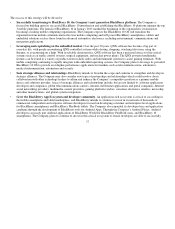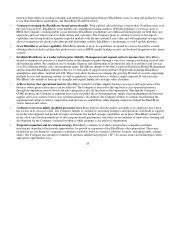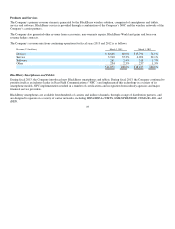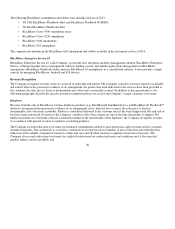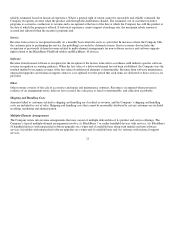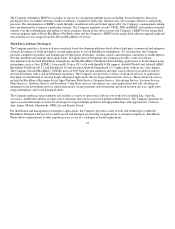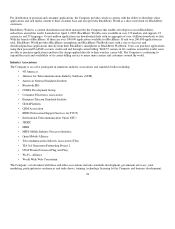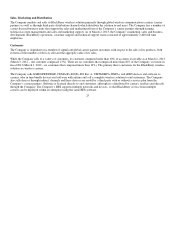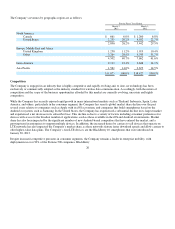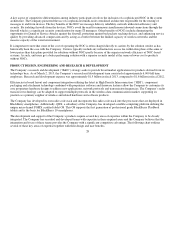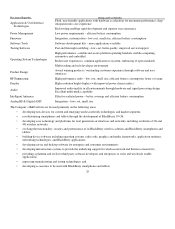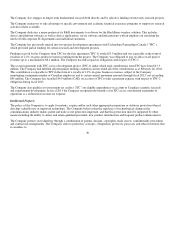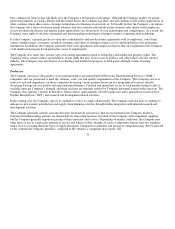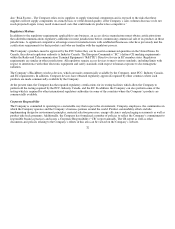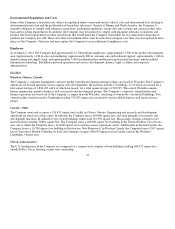Blackberry 2013 Annual Report Download - page 34
Download and view the complete annual report
Please find page 34 of the 2013 Blackberry annual report below. You can navigate through the pages in the report by either clicking on the pages listed below, or by using the keyword search tool below to find specific information within the annual report.
smartphones in combination with the BlackBerry Enterprise Server set the standard in mobile enterprise for secure, reliable and
manageable mobile access to enterprise resources and applications. However, trends towards BYOD deployments, wherein some
companies are allowing employees to connect their own smartphones to corporate networks, have increased competitive pressure on
the Company in the enterprise market. New products and services such as BlackBerry 10 smartphones with BlackBerry Balance,
which allows for the secure co-existence of enterprise and corporate data on BlackBerry devices, and BlackBerry Enterprise Service
10, the Company’s next generation BES that supports Mobile Device Management (MDM) services for BlackBerry 10 smartphones
and PlayBook tablets as well as iOS and Android based devices through a unified BlackBerry administration console, demonstrate the
Company’s continued innovation and leadership and are intended to further solidify the Company’s position in the enterprise market.
Strategic relationships in the wireless data communications industry are also evolving. Specific infrastructure manufacturers, network
operators, content providers and other businesses within the industry may currently be customers of, suppliers to, strategic partners
with, or investors in other businesses. The Company is currently working with a number of businesses, some of which are direct
competitors with each other and others of which are current or potential competitors of the Company. It is unclear to what extent
network infrastructure developers, enterprise software vendors, PC or tablet vendors, key network operators or content providers and
others will seek to provide integrated wireless solutions, including access devices developed internally or through captive suppliers.
Providers of major mobile operating system platforms that compete with the Company’s BlackBerry platform include Apple Inc.
(iOS), Google Inc. (Android), Microsoft Inc. (Windows Phone), and Nokia Corporation (Symbian). In the wireless data
communications access market, the Company is aware of a number of suppliers of access devices for public wireless data networks,
including: Apple Inc.; Amazon Inc., Dell, Inc.; Fujitsu Limited; General Dynamics Corporation; Hitachi America, Ltd.; HTC
Corporation; Huawei Technologies Co. Ltd.; LG Electronics Mobile Communications Company; Mitsubishi Corporation; Motorola
Mobility Holdings, Inc.; NEC Corporation; Nokia Corporation; Samsung Electronics Co., Ltd.; Sharp Corporation; Sony Corporation;
and ZTE Corporation. In addition, the Company faces competition from companies focused on providing middleware to facilitate
end-to-end wireless messaging solutions. Companies in this category include AirWatch LLC; BoxTone Inc.; Citrix Systems, Inc.,
Good Technologies; IBM Corporation; Microsoft Corporation; Mobile Iron Inc.; Notify Technology Corporation; Openwave Systems
Inc.; Seven Networks, Inc.; and Sybase, Inc. Some of the Company’s competitors have greater name recognition, larger customer
bases, and significantly greater financial, technical, marketing, public relations, sales, distribution and other resources than the
Company does.
A variety of approaches are being pursued as diverse handset and handheld vendors attempt to provide mobile access to corporate
data. These approaches include smartphones, superphones, other mobile data devices such as tablets and netbooks, a variety of
middleware offerings and other end-to-end integrated wireless solutions.
27


